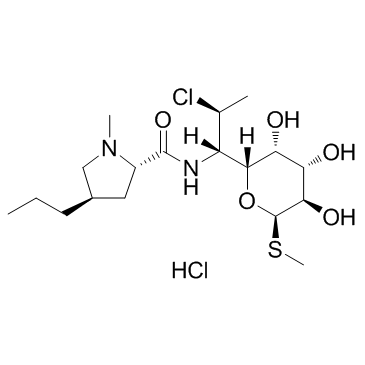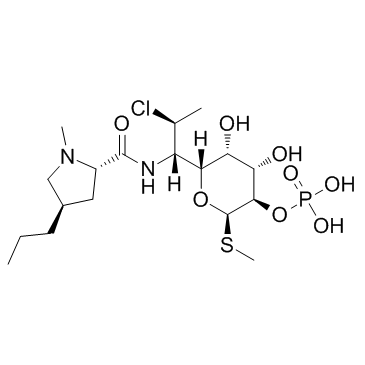CHEMICAL IDENTIFICATION
-
RTECS NUMBER :
-
GF2275000
-
CHEMICAL NAME :
-
Clindamycin, hydrochloride
-
CAS REGISTRY NUMBER :
-
21462-39-5
-
LAST UPDATED :
-
199706
-
DATA ITEMS CITED :
-
10
-
MOLECULAR FORMULA :
-
C18-H33-Cl-N2-O5-S.Cl-H
-
MOLECULAR WEIGHT :
-
461.50
-
WISWESSER LINE NOTATION :
-
T6OTJ BS1 CQ DQ EQ FYYG1&MV- BT5NTJ A1 D3 &GH
HEALTH HAZARD DATA
ACUTE TOXICITY DATA
-
TYPE OF TEST :
-
LD50 - Lethal dose, 50 percent kill
-
ROUTE OF EXPOSURE :
-
Oral
-
SPECIES OBSERVED :
-
Rodent - rat
-
DOSE/DURATION :
-
2193 mg/kg
-
TOXIC EFFECTS :
-
Behavioral - somnolence (general depressed activity)
-
REFERENCE :
-
TOIZAG Toho Igakkai Zasshi. Journal of Medical Society of Toho University. (Toho Daigaku Igakkai, 21-16, Omori-nishi, 5-chome, Ota-ku, Tokyo 143, Japan) V.1- 1954- Volume(issue)/page/year: 18,354,1971
-
TYPE OF TEST :
-
LD50 - Lethal dose, 50 percent kill
-
ROUTE OF EXPOSURE :
-
Intraperitoneal
-
SPECIES OBSERVED :
-
Rodent - rat
-
DOSE/DURATION :
-
745 mg/kg
-
TOXIC EFFECTS :
-
Behavioral - somnolence (general depressed activity)
-
REFERENCE :
-
TOIZAG Toho Igakkai Zasshi. Journal of Medical Society of Toho University. (Toho Daigaku Igakkai, 21-16, Omori-nishi, 5-chome, Ota-ku, Tokyo 143, Japan) V.1- 1954- Volume(issue)/page/year: 18,354,1971
-
TYPE OF TEST :
-
LD50 - Lethal dose, 50 percent kill
-
ROUTE OF EXPOSURE :
-
Subcutaneous
-
SPECIES OBSERVED :
-
Rodent - rat
-
DOSE/DURATION :
-
2618 mg/kg
-
TOXIC EFFECTS :
-
Behavioral - somnolence (general depressed activity) Behavioral - convulsions or effect on seizure threshold
-
REFERENCE :
-
TXAPA9 Toxicology and Applied Pharmacology. (Academic Press, Inc., 1 E. First St., Duluth, MN 55802) V.1- 1959- Volume(issue)/page/year: 21,516,1972
-
TYPE OF TEST :
-
LD50 - Lethal dose, 50 percent kill
-
ROUTE OF EXPOSURE :
-
Intramuscular
-
SPECIES OBSERVED :
-
Rodent - rat
-
DOSE/DURATION :
-
273 mg/kg
-
TOXIC EFFECTS :
-
Details of toxic effects not reported other than lethal dose value
-
REFERENCE :
-
NIIRDN Drugs in Japan (Ethical Drugs). (Yakugyo Jiho Co., Ltd., Tokyo, Japan) Volume(issue)/page/year: -,331,1990
-
TYPE OF TEST :
-
LD50 - Lethal dose, 50 percent kill
-
ROUTE OF EXPOSURE :
-
Oral
-
SPECIES OBSERVED :
-
Rodent - mouse
-
DOSE/DURATION :
-
2539 mg/kg
-
TOXIC EFFECTS :
-
Behavioral - somnolence (general depressed activity)
-
REFERENCE :
-
TOIZAG Toho Igakkai Zasshi. Journal of Medical Society of Toho University. (Toho Daigaku Igakkai, 21-16, Omori-nishi, 5-chome, Ota-ku, Tokyo 143, Japan) V.1- 1954- Volume(issue)/page/year: 18,354,1971
-
TYPE OF TEST :
-
LD50 - Lethal dose, 50 percent kill
-
ROUTE OF EXPOSURE :
-
Intraperitoneal
-
SPECIES OBSERVED :
-
Rodent - mouse
-
DOSE/DURATION :
-
361 mg/kg
-
TOXIC EFFECTS :
-
Details of toxic effects not reported other than lethal dose value
-
REFERENCE :
-
UPJOH* "Compounds Available for Fundamental Research, Volume II-6, Antibiotics, A Program of Upjohn Company Research Laboratory." (Kalamazoo, MI 49001) Volume(issue)/page/year: 2(6),-,1971
-
TYPE OF TEST :
-
LD50 - Lethal dose, 50 percent kill
-
ROUTE OF EXPOSURE :
-
Subcutaneous
-
SPECIES OBSERVED :
-
Rodent - mouse
-
DOSE/DURATION :
-
1036 mg/kg
-
TOXIC EFFECTS :
-
Behavioral - somnolence (general depressed activity) Behavioral - convulsions or effect on seizure threshold Lungs, Thorax, or Respiration - dyspnea
-
REFERENCE :
-
TOIZAG Toho Igakkai Zasshi. Journal of Medical Society of Toho University. (Toho Daigaku Igakkai, 21-16, Omori-nishi, 5-chome, Ota-ku, Tokyo 143, Japan) V.1- 1954- Volume(issue)/page/year: 18,354,1971
-
TYPE OF TEST :
-
LD50 - Lethal dose, 50 percent kill
-
ROUTE OF EXPOSURE :
-
Intravenous
-
SPECIES OBSERVED :
-
Rodent - mouse
-
DOSE/DURATION :
-
245 mg/kg
-
TOXIC EFFECTS :
-
Behavioral - somnolence (general depressed activity) Behavioral - convulsions or effect on seizure threshold
-
REFERENCE :
-
TXAPA9 Toxicology and Applied Pharmacology. (Academic Press, Inc., 1 E. First St., Duluth, MN 55802) V.1- 1959- Volume(issue)/page/year: 21,516,1972
-
TYPE OF TEST :
-
LD50 - Lethal dose, 50 percent kill
-
ROUTE OF EXPOSURE :
-
Intramuscular
-
SPECIES OBSERVED :
-
Rodent - mouse
-
DOSE/DURATION :
-
1100 mg/kg
-
TOXIC EFFECTS :
-
Behavioral - altered sleep time (including change in righting reflex) Behavioral - somnolence (general depressed activity) Behavioral - ataxia
-
REFERENCE :
-
TOIZAG Toho Igakkai Zasshi. Journal of Medical Society of Toho University. (Toho Daigaku Igakkai, 21-16, Omori-nishi, 5-chome, Ota-ku, Tokyo 143, Japan) V.1- 1954- Volume(issue)/page/year: 18,354,1971 *** NIOSH STANDARDS DEVELOPMENT AND SURVEILLANCE DATA *** NIOSH OCCUPATIONAL EXPOSURE SURVEY DATA : NOES - National Occupational Exposure Survey (1983) NOES Hazard Code - X4823 No. of Facilities: 69 (estimated) No. of Industries: 1 No. of Occupations: 3 No. of Employees: 3168 (estimated) No. of Female Employees: 1697 (estimated)
|

 CAS#:24729-96-2
CAS#:24729-96-2
